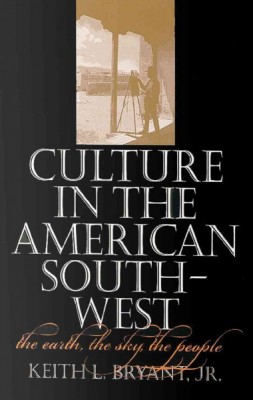| Culture in the American Southwest: The Earth, the Sky, the People Volume 12 Contributor(s): Bryant, Keith L. (Author) |
|
 |
ISBN: 1623492076 ISBN-13: 9781623492076 Publisher: Texas A&M University Press OUR PRICE: $22.46 Product Type: Paperback - Other Formats Published: October 2014 |
| Additional Information |
| BISAC Categories: - History | United States - General - Social Science | Anthropology - Cultural & Social |
| Dewey: 306.09 |
| Series: Tarleton State University Southwestern Studies in the Humani |
| Physical Information: 0.92" H x 6.75" W x 9.08" (1.27 lbs) 392 pages |
| Descriptions, Reviews, Etc. |
| Publisher Description: If the Southwest is known for its distinctive regional culture, it is not only the indigenous influences that make it so. As Anglo Americans moved into the territories of the greater Southwest, they brought with them a desire to reestablish the highest culture of their former homes: opera, painting, sculpture, architecture, and literature. But their inherited culture was altered, challenged, and reshaped by Native American and Hispanic peoples, and a new, vibrant cultural life resulted. From Houston to Los Angeles, from Tulsa to Tucson, Keith L. Bryant traces the development of "high culture" in the Southwest. Humans create culture, but in the Southwest, Bryant argues, the land itself has also influenced that creation. "Incredible light, natural grandeur, . . . and a geography at once beautiful and yet brutal molded societies that sprang from unique cultural sources." The peoples of the American Southwest share a regional consciousness--an experience of place--that has helped to create a unified, but not homogenized, Southwestern culture. Bryant also examines a paradox of Southwestern cultural life. Southwesterners take pride in their cultural distinctiveness, yet they struggled to win recognition for their achievements in "high culture." A dynamic tension between those seeking to re-create a Western European culture and those desiring one based on regional themes and resources continues to stimulate creativity. Decade by decade and city by city, Bryant charts the growth of cultural institutions and patronage as he describes the contributions of artists and performers and of the elites who support them. Bryant focuses on the significant role women played as leaders in the formation of cultural institutions and as writers, artists, and musicians. The text is enhanced by more than fifty photographs depicting the interplay between the people and the land and the culture that has resulted. |